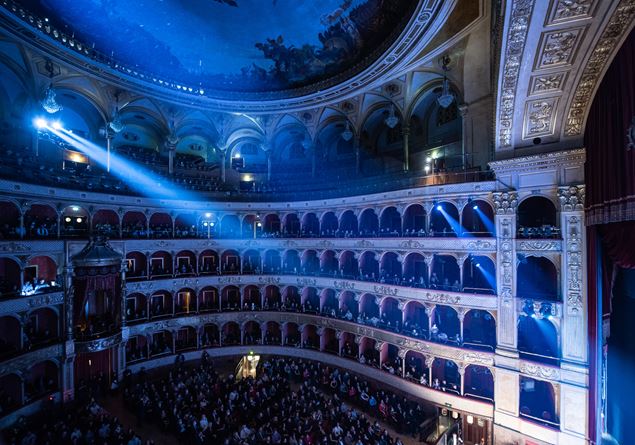“The time has come for Wagner!”, Michele Mariotti, musical director of the Opera di Roma theater, exclaims during the presentation of the new 2025/2026 season. It will be Lohengrinon the afternoon of November 27, to open a season that presents itself with 12 new productions, including 9 of Opera and 3 of dance; 14 operistic titles, 8 ballets on site, 3 tour of the body dance, a tour of the orchestra and 4 concerts. Three more titles for both the work and for the ballet, for a total of 13 evenings more than last season.
Sign of a live theater and in excellent health under the guidance of the superintendent Francesco Giambronein office since December 2021 and recently reconfirmed until 2030.
“Double dream It is the title we have chosen for the 2025-26 season “, says Giambrone,” a reference to the famous story of Arthur Schnitzler, where dream and reality intertwine and overturn each other, and which summarizes the profound essence of our artistic proposal and the vision that guides it. Ours is a theater that does not give up the imagination, which continues to believe in art as a space of elevation, enchantment, utopia; but at the same time it remains rooted in the living matter of the times we live, questioning reality with lucidity and taking position “
Lohengrin He returns to Costanzi after 50 years of absence and is faced for the first time by the three main interpreters involved: the musical director Michele Mariotti, the director Damiano Michieletto and the tenor Dmitry Korchak. “It’s a work,” explains Mariotti, “who will put all of us to the test. It is a historical drama, a fairy tale and a thriller. I can’t wait to immerse myself in these waters”.
Among the great titles of the opera repertoire, the season calendar La Bohème of Puccini, directed by David Livermore and the direction of Jader Bignamini and Alessandro Palumbo; Ariadne auf naxos by Strauss, directed by David Hermann and Maxime Pascal on the podium; Roméo et juliette by Charles Gounod, a title never appeared in the posters of the Capitoline lyrical, directed by Luca De Fusco, director of the theater of Rome from January 2024, and on the podium Daniel Oren. The traviata With the direction of Sofia Coppola, the costumes of Valentino and the musical direction of Francesco Ivan Ciampa; The wedding of Figaro by Mozart in the version staged in 2006 at the Salzburg Festival by the German director Claus Guth, with the debut of Emmanuel Tjeknavorian on the podium of the work of Rome; Tancredi by Rossini, with the direction of Emma Dante, the direction of Mariotti and the counter -class countertenor Carlo Vistoli in the role of the title; The Falstaff of Verdi with the direction of Mariotti and the direction of Tatjana Gürbaca. Space also for the Händel Baroque with The triumph of time and deception in a setting edited by Robert Carsen And the musical direction of Gianluca Capuano.Tito contemporary is Inferno, the work of the composer Lucia Ronchetti, former director of the Biennale Musica in Venice. A gem will be at the extraordinary recitation of Tosca At Costanzi on 1 November, broadcast by Rai Culture live on Rai3 in collaboration with the Ministry of Culture, to close the celebrations of the 125th anniversary of Puccini’s masterpiece.
In the various cast, in addition to the artists already mentioned, the rumors of Eleonora Buratto, Luca Salsi, Vittorio Grigolo, Maria Agresta, Raffaele Pe, Nino Machaidze, Markus Werba, Anna Bonititibus, Saimir Pirgu.
Great space for dancewith great classics such as Nutcracker (scheduled in the Christmas period) and Bayadère. But there is no shortage of exploration of the twentieth century and the contemporaneity with George Balanchine, Pina Bausch, Jerome Robbins, Jacopo Godani, Marco Goecke, Angelin Preljocaj and Benjamin Millepied.
Four concerts are also on the bill. Michele Mariotti directs three: Symphony n. 9 of Schubert and Vier Letzte Lieder of Strauss with the voice of Marina Rebeka; Rossini’s Petite Masse Masse in the orchestral version at Costanzi on October 17 and in the first version for only alone, choir, two piano and harmonium in the most collected space of the Basilica of San Vitale, in via Nazionale. That of March 5, 2026 will instead be an evening at the court of the kings of France, with the music of Lully, Marais and Rameau directed by the brilliant Italian violinist Italian French Emmanuel Reche-Caserta.
Then there is, integrated and parallel with the Costanzi program, the season scheduled at the National Theater, which offers six titles with tributes to ancient literature and that of the twentieth century through prose, work and ballet shows.


